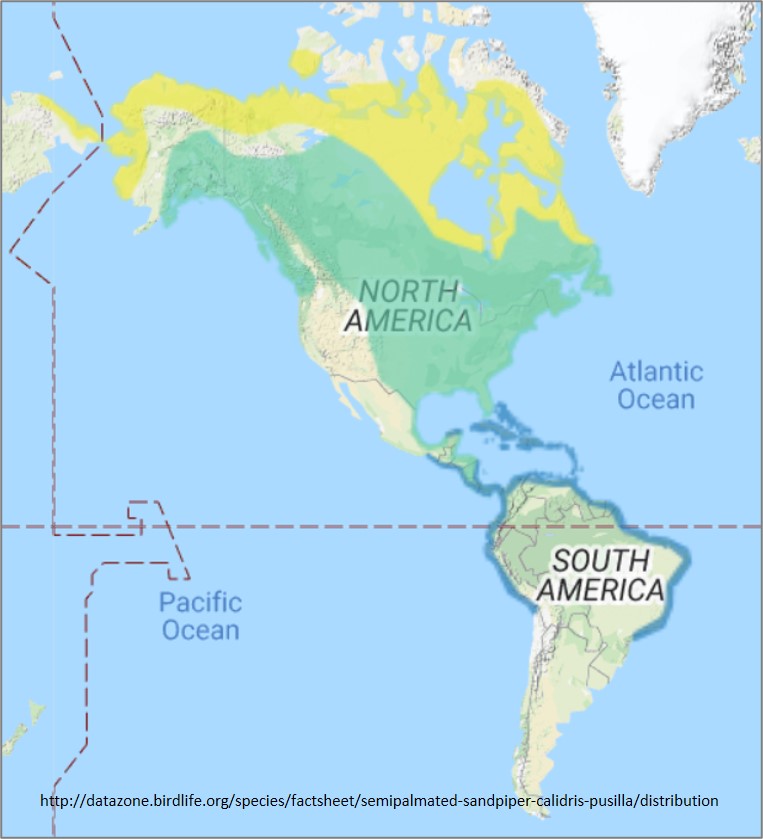Around the world in sixteen blogs
2020 was a strange year, as covid swept around the world and more and more of us faced travel bans. Throughout it all, waders/shorebirds continued to fly thousands of kilometres in spring and autumn.
Five out of sixteen of the year’s WaderTales blogs focused on international migration studies, using a mixture of colour-rings, geolocators and satellite tags. It was particularly interesting to think more about ‘teenage’ waders – the period between fledging and first breeding. It may be a couple of years or more before shorebirds return to their breeding grounds; what do we know about what happens during this period? Are vulnerable and threatened species and the sites that they rely on receiving enough conservation support during these important, teenage years?
- Teenage waders is ostensibly about Hudsonian Godwits that spend the non-breeding season in Chile and breed in Alaska. Juan Navedo & Jorge Ruiz noticed that a small number of satellite-tagged birds headed for Argentina instead of Alaska in April. This led to the discovery of flocks of young Hudsonian Godwits (and adults that choose not to breed in a particular year) in the pampa wetlands – areas that are under threat from industrial-scale farming.
- Spoon-billed Sandpipers: track & trace follows tagged Spoon-billed Sandpipers, as they travel from their breeding sites in Russia, through China and beyond. This is an amazing story; thirteen birds carrying back-mounted transmitters have revealed information that will enable the targeting of conservation measures to support a global population that is estimated to be just 660 birds.
- Gap year for sandpipers is based upon a Peruvian Semipalmated Sandpiper paper that investigates the survival advantage of not migrating north to breed in any particular year. It reveals that taking a gap year may be a sensible strategy in some circumstances.
- Which Icelandic Oystercatchers cross the Atlantic? Around 30% of Oystercatchers remain in Iceland for the winter, with the rest of the population flying south across the Atlantic in autumn. Having made an initial ‘decision’ to be a resident or a migrant, an individual sticks to this strategy but what determines whether a particular Oystercatcher becomes a migrant?
- A Rhapsody of Whimbrel asks whether Whimbrel use time and weather cues in their travel ‘planning’ and whether their plans change during the course of their lives. By looking at weather patterns encountered by tagged birds, flying between western Africa and Iceland, Camilo Carneiro shows that old birds may be able to learn new tricks.
A Scottish trio
2020 seems to be the year of the Scottish WaderTales blog, with three spring/summer stories about research led by RSPB Scotland staff.
- Migration of Scottish Greenshank summarises a study of a small number of breeding birds, using a mixture of colour-ring sightings and geolocator records. Unlike their cousins, that breed in eastern Russia and migrate to Australia or even New Zealand, Greenshank nesting in northern Scotland are short -distance migrants, mostly staying within Britain & Ireland for the whole of their lives
- Trees, predators and breeding waders is all about how the presence of woodland affects the distribution of mammalian predators, even after the trees have gone. Species such as Curlew and Dunlin are benefiting from the removal of forestry plantations from the peat blogs of Forsinard, in north-east Scotland. We discover that it takes a long time for habitat restoration to deliver conservation benefits because of residual levels of predator pressure.
- Scotland’s Dotterel: still hanging on discusses how climate changes are affecting the distribution and numbers of Scottish Dotterel. High up on the Cairngorm plateau, scientists have been studying the links between Dotterel numbers and climate change. The distribution of nests seems to reflect local weather conditions but declining numbers may be more of an African problem.
Nesting waders
- Where to nest? Almost all waders/shorebirds nest on the ground which means that nests are vulnerable to predation. Two main strategies have evolved to minimise egg losses, cryptic egg colouration in open settings and hiding nests in vegetation. A study in Iceland investigates which strategy appears to be more successful and in what circumstances. Do Iceland’s open-nesters (Oystercatcher, Golden Plover & Whimbrel) fare as well as nest-hiders (Redshank, Snipe & Black-tailed Godwit)?
- Curlews and foxes in East Anglia raises some interesting conservation issues. Might it be possible to attract breeding Curlew to patches that can be protected from potential predators? Habitat improvement measures that have been designed to help Stone Curlews are popular with Curlews too. Could shallow soil disturbance be used to support Curlew conservation?
Black-tailed Godwits
WaderTales started out as a way to provide feedback to the volunteers who report colour-ringed Black-tailed Godwits. Most of the twenty blogs about the species refer to islandica but the two in 2020 focus on limosa. The first blog is a follow-up to the 2019 story about a plan to build a new airport within the Tagus Estuary. This threatens to undo much of the good work of Project Godwit – trying to rebuild the English breeding population in the Fens. To raise money for this project, Jen and Mark Smart cycled 1000 km across England, vising many of the sites where head-started Project Godwit chicks have been seen. It was a great opportunity to provide updates on the migration stories of these special birds.
- Black-tailed Godwits are on their way home reveals the importance of the Tagus Estuary (Portugal) to England’s breeding limosa Black-tailed Godwits.
- Cycling for waders is about the head-starting initiative to rebuild the English breeding population of Black-tailed Godwit – and a sponsored cycle ride to support Project Godwit & International Wader Study Group.
Behaviour
Two of this year’s blogs are about bird behaviour, other than migration.
- Disturbed Turnstones focuses upon a paper about the changing distribution of Turnstone in northeast England. As numbers have declined, birds have withdrawn from beaches with more people and dogs. Off-shore roosts seem to have become increasingly important.
- Flagging up potential problems discusses safety issues associated with using flags and flag-mounted geolocators when studying waders. At the heart of the blog is a study of Common Sandpiper survival and migration but there is additional information about ways to minimise problems that may occur when using leg-flags.
Book reviews
Occasionally, the publication of a new book about waders/shorebirds is used as a hook upon which to hang a WaderTales blog. Two new books, Red Sixty Seven and Flight Lines, were treated in this way in 2020.
- Nine red-listed UK waders discusses why nine species of wader find themselves on the UK red list of species of conservation concern). The book, which covers all of the 67 species on the UK Red List, is raising money to help fund scientific research by BTO and RSPB.
- Plovers from the north is a blog about the global migration patterns of Grey Plovers (Black-bellied Plovers). There is an Australian focus but this was a good opportunity to summarise recent research from around the world.
Previous summaries
WaderTales blogs are written by Graham Appleton, to celebrate waders and wader research. Many of the articles are based on previously published papers, with the aim of making wader science available to a broader audience.The intention is to add one or two new blogs each month. You can sign up to receive an e-mail notification when a new one is published. There’s a full list of blogs here.




















